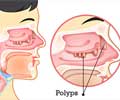The Sinonasal Outcome Test-16 (SNOT-16) appears to be effective in assessing how well treatments improve the disease specific quality of life (QOL) of adult patients with

Jane Garbutt, M.B., Ch.B., and colleagues from Washington University, St. Louis, sought to evaluate how reliable, valid and responsive (able to detect small but important changes over time) the modified SNOT-16 was in adult patients with acute rhinosinusitis treated in a primary care setting. Their study was conducted during a randomized, controlled trial of antibiotic treatment for the condition. The modified SNOT-16, which gathers information on 16 sinus-related symptoms, was completed in person and by telephone on the first day of the study, and by telephone on days three, seven and 10. The questionnaire asked how severe and frequent symptoms were and how much they bothered patients. Participants were between 18 and 70 years old, had a diagnosis of acute rhinosinusitis from a primary care physician and initially reported their symptoms as moderate to very severe.
Of the 166 patients randomized in the treatment study, 78 percent were white and 36 percent were male. Statistically significant differences in terms of symptom severity and how bothered patients felt were identified by the modified SNOT-16, demonstrating the instrument's validity. Analysis of results demonstrated the questionnaire's internal consistency and sensitivity to clinical changes in patients' conditions. Researchers noted that the tool was quick and easy to use, and that scores were lower when the questionnaire was conducted by telephone on the same day following completion during a face-to-face interview.
"In conclusion, we found the modified SNOT-16 to be valid, responsive, and easy to use, and we recommend its use to assess change in disease-related QOL in interventions targeting patients with acute rhinosinusitis," the authors write. "It is important to note that if the planned mode of administration is by telephone interview, then the baseline assessment must also be by telephone interview."
Source-Eurekalert















